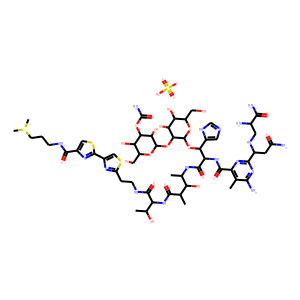| IUPAC Name | 3-[[2-[2-[2-[[2-[[4-[[2-[[6-amino-2-[3-amino-1-[(2,3-diamino-3-oxopropyl)amino]-3-oxopropyl]-5-methylpyrimidine-4-carbonyl]amino]-3-[(2R,3S,4S,5S,6S)-3-[(2R,3S,4S,5R,6R)-4-carbamoyloxy-3,5-dihydroxy-6-(hydroxymethyl)oxan-2-yl]oxy-4,5-dihydroxy-6-(hydroxymethyl)oxan-2-yl]oxy-3-(1H-imidazol-5-yl)propanoyl]amino]-3-hydroxy-2-methylpentanoyl]amino]-3-hydroxybutanoyl]amino]ethyl]-1,3-thiazol-4-yl]-1,3-thiazole-4-carbonyl]amino]propyl-dimethylsulfanium;hydrogen sulfate |
| InChI | InChI=1S/C55H83N17O21S3.H2O4S/c1-20-33(69-46(72-44(20)58)25(12-31(57)76)64-13-24(56)45(59)82)50(86)71-35(41(26-14-61-19-65-26)91-54-43(39(80)37(78)29(15-73)90-54)92-53-40(81)42(93-55(60)88)38(79)30(16-74)89-53)51(87)66-22(3)36(77)21(2)47(83)70-34(23(4)75)49(85)63-10-8-32-67-28(18-94-32)52-68-27(17-95-52)48(84)62-9-7-11-96(5)6;1-5(2,3)4/h14,17-19,21-25,29-30,34-43,53-54,64,73-75,77-81H,7-13,15-16,56H2,1-6H3,(H13-,57,58,59,60,61,62,63,65,66,69,70,71,72,76,82,83,84,85,86,87,88);(H2,1,2,3,4)/t21?,22?,23?,24?,25?,29-,30+,34?,35?,36?,37+,38+,39-,40-,41?,42-,43-,53+,54-;/m0./s1 |
| Reference | 1. J Foot Surg. 1989 Mar-Apr;28(2):141-4.<br />
A perspective study using bleomycin sulfate in the treatment of plantar verrucae.<br />
Sollitto RJ(1), Napoli RC, Gazivoda PL, Hart TJ.<br />
Author information:<br />
(1)Department of Podiatric Surgery, Kennedy Memorial Hospitals at Saddle Brook, New Jersey.<br />
The authors present a perspective study using bleomycin sulfate in the treatment of plantar verrucae. Also, they review the literature concerning this modality. Although the effective cure rate obtained in this study was less than that reported previously, the authors found bleomycin to be particularly effective in the treatment of mosaic verrucae.<br />
2. J Dermatol Surg Oncol. 1985 Oct;11(10):972-3.<br />
Bleomycin sulfate–postoperative intralesional usage for giant condylomata.<br />
Buecker JW, Heaton CL.<br />
A patient with giant condyloma of the glans penis was successfully treated with conservative surgical excision. Postoperatively, intralesional bleomycin sulfate was utilized in an attempt to prevent tumor recurrence. Follow-up to 2 years has been unremarkable for clinical regrowth.<br />
3. Oncology. 1984;41(2):114-9.<br />
Carcinogenicity of bleomycin sulfate and peplomycin sulfate after repeated subcutaneous application to rats.<br />
Habs M, Schmähl D.<br />
Bleomycins (BLM) are widely used as antineoplastic agents either alone or in combination regimens. Results of earlier studies in experimental animals were said to be inadequate to evaluate the carcinogenicity of BLM, which is a known mutagen. In a dose-response study, BLM and peplomycin (PEP) were investigated in Sprague-Dawley rats of both sexes. For the first 10 weeks weekly doses of 0.35, 0.70, 1.40, and 2.80 mg/kg BLM and of 0.32, 0.63, 1.25, 2.50, and 5.0 mg/kg PEP were applied subcutaneously (BLM: 30 male and 30 female rats/group; PEP: 25 male and 25 female rats/group). In the case of BLM, thereafter the doses were given once every fortnight either for 1 year (BLM: 1.40 and 2.80) or for life (lower doses). In the case of PEP, application of the high doses was stopped after the 13th time (5.0: 10 X 1/week and 3 X 1 every 2 weeks) and the 19th application (2.5 mg: 10 X 1/week and 9 X 1/every 2 weeks). After the 10th dosing, the remaining groups were treated once every fortnight for life. 60 male and 60 female rats served as solvent-treated (physiological saline) controls. The animals were observed for life. Repeated doses of BLM and PEP reduced body weight and life expectancy of the animals in a dose-related pattern. Tubular cell damages and cell proliferations were seen as a symptom of major toxicity in the kidneys. In this model BLM and PEP are carcinogenic: treatments resulted in significant dose-related incidences of animals with tumors at the site of application (fibrosarcomas) and with renal tumors (adenomas, adenocarcinomas, sarcomas).<br />
|

